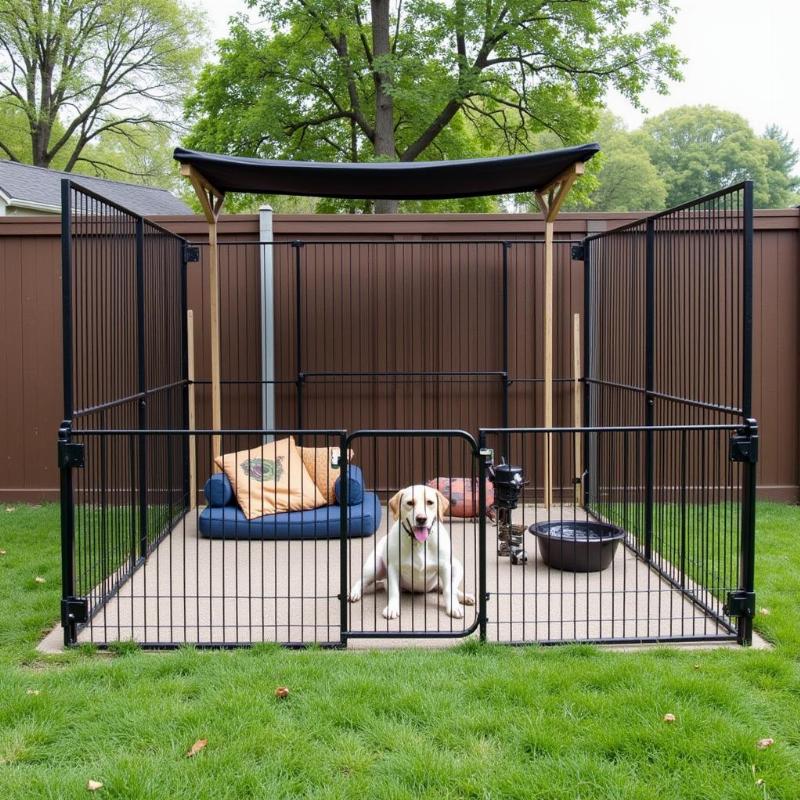A dog tie out, also known as a trolley system or runner, is a device that allows your dog to have supervised outdoor time while remaining restricted to a specific area. It typically consists of a cable or rope attached to a stake or pulley system, which is then connected to your dog’s collar or harness. Understanding what a dog tie out is and how to use it responsibly is essential for ensuring your dog’s safety and well-being. Choosing the right tie out and using it correctly can provide your furry friend with a safe and enriching outdoor experience.
Understanding Dog Tie Outs: Safety and Considerations
Before using a dog tie out, it’s crucial to understand the potential risks and take necessary precautions. A tie out should never be a substitute for regular walks and playtime. Leaving a dog tied out for extended periods can lead to boredom, frustration, and even aggression. Furthermore, improperly used tie outs can pose a strangulation hazard. Always supervise your dog while they’re tethered and ensure the tie out is properly installed and in good condition. The length of the tie out should allow your dog to move around comfortably without reaching hazardous areas, such as roads or swimming pools.
Choosing the right type of tie out is also important. A cable tie out is generally more durable and chew-resistant than a rope tie out, but it can be heavier and less flexible. A trolley system offers more freedom of movement, especially in larger yards. Select a tie out appropriate for your dog’s size and temperament. For smaller dogs, a lighter tie out will suffice, while larger, more powerful breeds require a heavier-duty option.
Setting Up a Safe and Comfortable Tie Out Area for Your Dog
Creating a dedicated tie-out area can enhance your dog’s outdoor experience. Choose a level, well-drained spot away from obstacles and potential hazards. The area should be free of debris, toxic plants, and anything your dog could chew on or ingest. Provide shade and water to keep your dog comfortable, especially during warmer months.
 Preparing a Safe Dog Tie-Out Area
Preparing a Safe Dog Tie-Out Area
Consider the terrain and choose a stake or anchor that will securely hold the tie out in place. For softer ground, a spiral stake might be suitable, while a ground anchor is better for harder surfaces. Ensure the stake or anchor is deep enough to prevent your dog from pulling it out.
Choosing the Right Tie Out for Your Dog’s Size and Breed
Selecting the appropriate tie out is crucial for your dog’s safety and comfort. The length and material of the tie out should be appropriate for your dog’s size and breed. A small dog needs a shorter and lighter tie out compared to a larger breed. Similarly, a strong, energetic dog requires a more robust tie out that can withstand their strength. Always check the weight limit specified by the manufacturer to ensure the tie out is suitable for your dog.
Using a harness instead of a collar is highly recommended when using a tie out. Connecting the tie out to a collar can put pressure on your dog’s neck and pose a choking hazard. A harness distributes the pressure more evenly across the body, reducing the risk of injury.
Conclusion
A dog tie out can be a useful tool for providing your dog with supervised outdoor time, but it’s essential to use it responsibly. Prioritize your dog’s safety and well-being by selecting the right tie out, setting up a safe area, and supervising your dog while they are tethered. Remember, a tie out should never replace regular walks, playtime, and interaction. By following these guidelines, you can ensure your dog enjoys a safe and enriching outdoor experience.
FAQ
- How long can I leave my dog on a tie out? Never leave your dog tied out for extended periods. Short, supervised periods are best.
- What type of tie out is best for a large dog? A heavy-duty cable or trolley system is recommended for larger, stronger breeds.
- Should I use a collar or a harness with a tie out? Always use a harness to avoid putting pressure on your dog’s neck.
- What should I do if my dog gets tangled in the tie out? Stay calm and untangle your dog carefully. Inspect the tie out for damage and replace it if necessary.
- Can I use a tie out as a permanent solution for containing my dog? No, a tie out should never be a substitute for proper fencing and regular exercise.
- What are the signs of a dog being stressed on a tie-out? Whining, barking excessively, pacing, and attempts to chew the tie-out are signs of stress.
- Where can I find reliable dog tie outs? Pet stores and online retailers offer a variety of dog tie outs. Be sure to choose a reputable brand.
Related Articles on Beautdogs.us
- dosage of oil of oregano for dogs per day
- what is a natural antibiotic for a dog
- how to use coconut oil for dog ear infection
- best dog shampoo for bulldogs
Beautdogs.us is your premier online resource for comprehensive dog care information, breed insights, and product recommendations. We cater to both new and experienced dog owners, providing expert advice and guidance on everything from nutrition and training to grooming and health. Beautdogs.us connects you with a wealth of knowledge and resources to help you provide the best possible care for your canine companion. Contact us today for personalized support at [email protected] or +1 501-555-7529. Visit Beautdogs.us for more information.